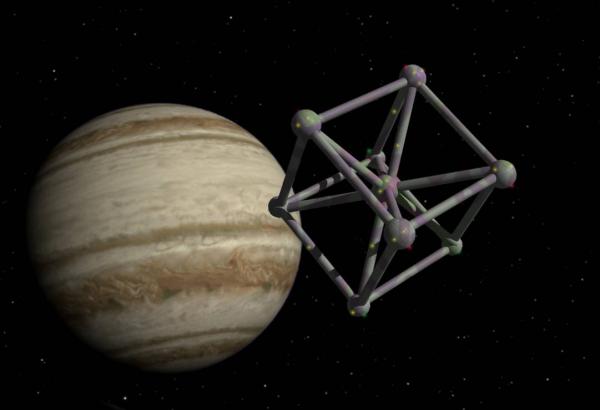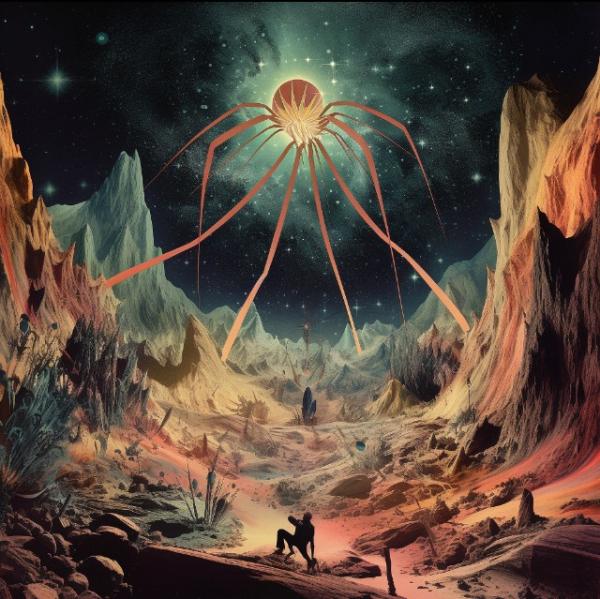BY LETTER
Paintbox Habitat
Culture and Society > Fine Arts > Perfect Art
Galactography > Other Major Polities, Empires, and Meta-Empires > Sagittarius Transcultural Cooperation
Culture and Society > Fine Arts > Visual Arts
Galactography > Other Major Polities, Empires, and Meta-Empires > Sagittarius Transcultural Cooperation
Culture and Society > Fine Arts > Visual Arts
 Image from Steve Bowers | |
| A large orbiting megastructure arranged into a cubic formation, with a well-established artistic tradition | |
System Data Panel | |
| Allegiance | Sagittarius Transcultural Cooperation |
|---|---|
| Stellar system | Babaluma |
| Stellar Type | K3.3 V |
| Luminosity | 0.24 x Sol |
| Constellation | Sagittarius |
| Right ascension | 17.7767 |
| Declination | -29.2501 |
| Distance from Sol | 2998 ly |
| Colonised | 5208 AT |
| Planetary System | Two superterrestrials (Vilt and Duncand) in the inner system: three gas giant worlds in the outer system (Geesen, Ryte and Kranke); Paintbox Habitat orbits the innermost gas giant, Geesen. |
A large hybrid habitat was constructed from several rocky moons orbiting Geesen, one of the gas giants in this system; the construction of this large structure was achieved in stages, with the large corner microgravity habitats completed first. These spherical structures do not rotate and are each four thousand kilometres in diameter, filled with Terran standard breathable atmosphere. A slightly larger sphere was constructed in the geometric centre of this array; this structure is a computronium node inhabited by several S:1 and S:2 transapients.
By 6000 AT these spheres were finally connected by twenty rotating cylinders nearly twenty thousand kilometres long, which spin to produce half of Earth's gravity.
The Paintbox Artistic Movement
During the Post-ComEmp era, Geesen Habitat (as it was originally known) developed a rich artistic culture, combining thousands of years of influences from throughout the Terragen Sphere. Many artists used external art generation software to help them achieve the results they wanted; others altered themselves somatically and psychologically to augment their capabilities.One popular form of art generation technology was smart paint; this was a form of interactive utility fluid that could respond to the brushwork of the artist by altering, elaborating and improving the finished result in various ways. Painted landscapes could either become more detailed or more impressionistic, extra details could be generated in keeping with the general tone or subject of the work, and a broad range of influences could be incorporated at the suggestion of the artist. In many cases the artwork would evolve during the act of painting due to input via the artist's direct neural linkage. Since painting became a leading form of artistic expression in Geesen habitat, this location has become known as The Paintbox in a variety of local and interstellar languages.
In some cases, an elaborate three-dimensional model of the landscape concerned may be generated by the smart paint software, a model which can extend for an arbitrary distance; this model can be stored in required and used as backgrounds for other paintings, such as portraits. Since the smart paint can also display moving backgrounds, these painted images can be animated, and may include independently sentient or even fully sophont individuals within its frame. Some paintings are home to a small population of sophont persons who perceive their environment as fully three-dimensional, no matter how outlandish it may be. These virtual painted characters quite often decide to migrate out of the picture and inhabit other virtual worlds elsewhere, or sometimes become incarnate persons in the real-life, physical world.
Virtual realities created by artists in the Paintbox habitat are often copied and expanded elsewhere, because of the elaborate and often aesthetically pleasing qualities. Many cybercosms established in Quint and elsewhere are inspired by artworks first created in Geesen. Conversely, a number of virtual sophonts have migrated into the Paintbox habitat in order to inhabit the original artworks; often these artworks are displayed in galleries inside the cylinders and spheres of Paintbox, each flat picture frame giving a glimpse into the three-dimensional virtual world beyond.
 Image from Keith Wigdor and Midjourney AI | |
| The flat images created by smart paint in Paintbox Habitat are often elaborate worlds in their own right, inhabited by a varied population of sophonts. | |
A number of important works of Perfect Art have been created here, although the artists of this world are exclusively modosophont in toposophic level. A large proportion of the artworks produced here are collaborative works, often utilising advanced art generation systems which may or may not be sophont themselves, and may incorporate contributions by virtual citizens which inhabit the worlds created here.
Architecture and Sculpture
In the last two thousand years Paintbox Habitat has also become renowned for three-dimensional artforms, particularly architecture (a tradition which started with the design of art galleries, of which there are many millions of examples within Paintbox hab, both large-scale ones and smaller, more domestic examples). Many novel developments in architectural style have originated here, or have been developed to new levels.Another example of the plastic arts which has become increasingly important here is sculpture. Like many paintings created in Paintbox hab, a significant fraction of the statues produced on this world are themselves sophont entities. These sophont statues generally experience the world with a very slow subjective time rate, and often they appear to be completely static to most observers (even though they may be moving gradually from location to location). Such moving statues habitually adopt a particular way of walking that maintains their balance at all times, which sometimes may look a bit ungainly. Sophont sculptures of this kind often emigrate out of the Babaluma system, and can be found in many locations throughout the STC and beyond.
As well as sophont, moving sculptures, Paintbox artists produce many static statues and abstract pieces, from the very small to the very large; some artworks of this kind double as architecture and are used as homes and galleries, and some are exported to other systems either as completed works or in data form.
Related Articles
Appears in Topics
Development Notes
Text by Steve Bowers
Initially published on 28 June 2023.
Initially published on 28 June 2023.






